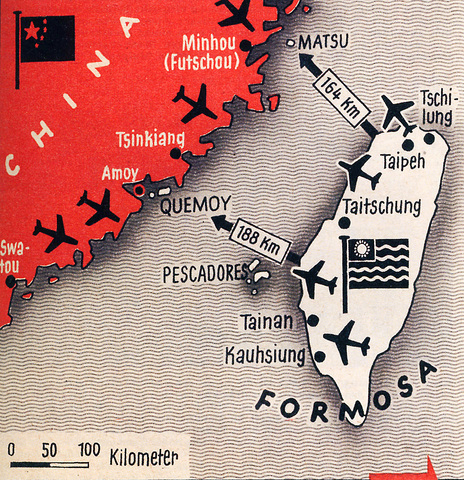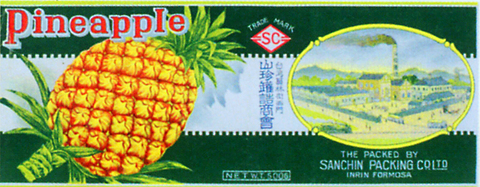People in Taiwan seem to have a fascination with maps, which is odd considering that a vast majority of those published in Taiwan, be they tourist or transport maps, are incorrect and impossible to comprehend.
The population might be cartographically challenged, but this doesn't stop books focusing on old maps of Taiwan from becoming bestsellers, copies of the Council for Cultural Affairs' (CCA,
And the current Taiwan in Maps (

PHOTOS COURTESY OF NATIONAL TAIWAN MUSEUMN
Taiwan in Maps is one of the largest exhibitions to be hosted by the museum in recent years, and the extensive and fascinating displays are located in exhibition halls on all three floors of the museum.
Jointly organized by the CCA and the museum, the exhibition features dozens of original maps and an equal number of reproductions and copies, along with photographs and other artifacts related to cartography in Taiwan.
While those with a whim for cartography and/or Taiwan history will have already seen some of the better-known maps on display and in various publications, there are still plenty of maps in the exhibition that will stoke the interests of anyone with an eye for geography or history.

The exhibition is well-organized and covers every conceivable topic and theme, from the earliest maps of Taiwan hand drawn by Portuguese and Spanish explorers in the 15th century to explanations of cutting-edge satellite imagery used by cartographers now.
Along with the multitude of geographic and topographic maps, there are also plenty of demographic maps on display. These include maps that plot Taiwan's indigenous peoples, the nation's economic growth, Taiwan's farming production and its transportation networks.
Although the maps are far too numerous to give a detailed account of all those on display, a couple of the most eye-catching charts include a simplified military map from 1958 showing the possible flight paths of military aircraft in the event of war with China, and a highly detailed map of Taiwan drawn by members of the Royal Geographic Society in 1864.
Taiwan in Maps is comprehensive and gives visitors insight into the history of cartography in Taiwan, but it is not without its flaws. As is all too often the case with exhibitions in Taiwan, be they at national or regional level, the lack of English-language information is big disappointment. Considering President Chen Shui-bian (
language material is in this instance best described as deplorable.
In addition to the exhibition, the museum has also published a comprehensive guidebook, which features a myriad of glossy photographs and explanations of many of the maps on display. Like the explanations that accompany the exhibits, the Taiwan in Maps guidebook is only available in Chinese.
Event Information:
What: Taiwan in Maps (
Where: National Taiwan Museum (
When: Through Sept. 18

As I finally slid into the warm embrace of the hot, clifftop pool, it was a serene moment of reflection. The sound of the river reflected off the cave walls, the white of our camping lights reflected off the dark, shimmering surface of the water, and I reflected on how fortunate I was to be here. After all, the beautiful walk through narrow canyons that had brought us here had been inaccessible for five years — and will be again soon. The day had started at the Huisun Forest Area (惠蓀林場), at the end of Nantou County Route 80, north and east

Specialty sandwiches loaded with the contents of an entire charcuterie board, overflowing with sauces, creams and all manner of creative add-ons, is perhaps one of the biggest global food trends of this year. From London to New York, lines form down the block for mortadella, burrata, pistachio and more stuffed between slices of fresh sourdough, rye or focaccia. To try the trend in Taipei, Munchies Mafia is for sure the spot — could this be the best sandwich in town? Carlos from Spain and Sergio from Mexico opened this spot just seven months ago. The two met working in the

Exceptions to the rule are sometimes revealing. For a brief few years, there was an emerging ideological split between the Democratic Progressive Party (DPP) and Chinese Nationalist Party (KMT) that appeared to be pushing the DPP in a direction that would be considered more liberal, and the KMT more conservative. In the previous column, “The KMT-DPP’s bureaucrat-led developmental state” (Dec. 11, page 12), we examined how Taiwan’s democratic system developed, and how both the two main parties largely accepted a similar consensus on how Taiwan should be run domestically and did not split along the left-right lines more familiar in

A six-episode, behind-the-scenes Disney+ docuseries about Taylor Swift’s Eras Tour and Rian Johnson’s third Knives Out movie, Wake Up Dead Man, are some of the new television, films, music and games headed to a device near you. Also among the streaming offerings worth your time this week: Chip and Joanna Gaines take on a big job revamping a small home in the mountains of Colorado, video gamers can skateboard through hell in Sam Eng’s Skate Story and Rob Reiner gets the band back together for Spinal Tap II: The End Continues. MOVIES ■ Rian Johnson’s third Knives Out movie, Wake Up Dead Man